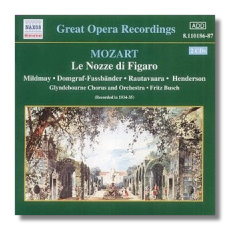
The Internet's Premier Classical Music Source
Related Links
- Mozart Reviews
- Latest Reviews
- More Reviews
-
By Composer
-
Collections
DVD & Blu-ray
Books
Concert Reviews
Articles/Interviews
Software
Audio
Search Amazon
Recommended Links
Site News
 CD Review
CD Review
Wolfgang Mozart

The Marriage of Figaro
- Aulikki Rautavaara (Countess Almaviva)
- Audrey Mildmay (Susanna)
- Luise Helletsgruber (Cherubino)
- Willi Domgraf-Fassbänder (Figaro)
- Roy Henderson (Count Almaviva)
- Heddle Nash (Don Basilio)
- Norman Allin/Italo Tajo (Don Bartolo)
Glyndebourne Festival Orchestra & Chorus/Fritz Busch
Naxos Historical 8.110186-87 ADD monaural 2CDs: 62:19, 74:28
This was the very first complete (or nearly so) Figaro to be recorded. Even then, the recording's producers and musicians didn't begin work on it confident of what the outcome would be. The newly born Glyndebourne Festival in Sussex, England presented an excellent opportunity to record Figaro while it was being presented on stage in June 1934. Initially, to test both the market and the artistic viability of the project, it was decided that just a selection of the opera's ensembles would be recorded, and this is exactly what happened at that time. But soon after, with the opera one-third complete, producer Fred Gaisberg was anxious to record the rest. This couldn't happen until June 1935, however. The Glyndebourne cast remained the same, except for Norman Allin's Bartolo, so he was replaced with Italo Tajo for the rest of the recording sessions.
By today's standards, there are several less than satisfactory aspects to this 1934-35 Figaro. One is the excision of all the secco recitatives. While I can't imagine Don Giovanni without its recitatives, Figaro just passes muster this way, and each act is thereby reduced to a span of around thirty convenient minutes – the length of a standard TV sitcom, by the way! There are other cuts. For example, Act One loses the "Giovani liete" choruses, Act Three loses the sextet, and Act Four loses Barbarina's cavatina, Marcellina's song about the he-goat and the she-goat, and Basilio's "In quegli anni." While the opera isn't reduced to nonsense by these excisions, one had better know one's Figaro before coming to this recording.
The singing is variable. Roy Henderson's wobbly and unmenacing Count can't stand up to any of his successors and Luise Helletsgruber's Cherubino lacks character. Mildmay and Rautavaara also have more than a few moments of unsteadiness as Susanna and the Countess, respectively. All of these singers are fine, however, in the ensembles, and it is in these sections of the score – not in the arias – that this recording achieves the most viability. Heddle Nash, later known as a romantic tenor, is a surprisingly oily, cackling Basilio, very much against type, and Tajo's Vengeance aria is authoritative. Domgraf-Fassbänder's dry, personable Figaro is on the highest rung of all. He's pretty much the star of the show, which is a good thing, as the opera is named after him! Fritz Busch keeps everything bustling along, sometimes much too quickly for the singers' good.
As an appendix, Naxos includes Cherubino's two arias sung with an adorable pout by Conchita Supervia, and the Countess's two arias in regal recordings by Eleanor Steber. These bonuses expose the individual shortcomings of the Glyndebourne cast. Naxos also includes, to less benefit, Lina Pagliughi's "Deh vieni, non tardar."
The booklet contains a track listing, a history of the Glyndebourne recording, brief bios of some of the singers, and a plot synopsis, with omitted sections enclosed in brackets. The lack of a full libretto is another reason first-time Figarophiles should save this recording until later.
Ward Marston's fine transfers leave in some of the surface hiss, but one's ears soon forget it, and one is pleased to note the immediacy the voices and the amount of orchestral detail still present.
Copyright © 2002, Raymond Tuttle


















